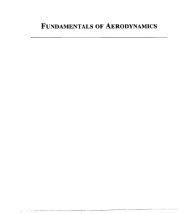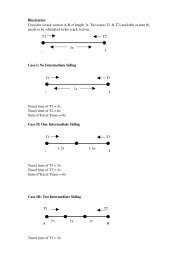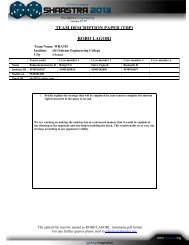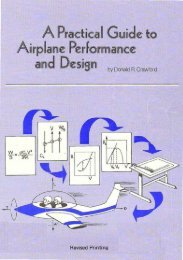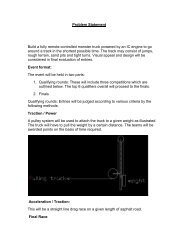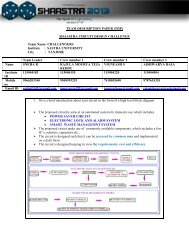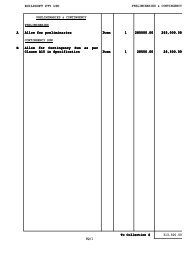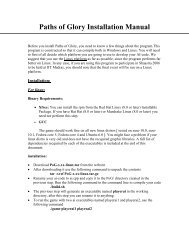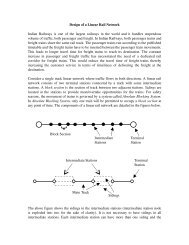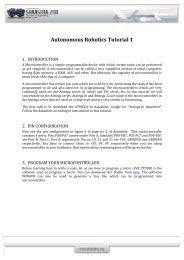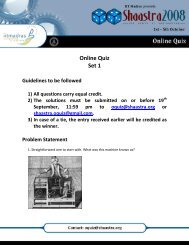Robo_Lagori_Problem_Statement_v.2 - Shaastra
Robo_Lagori_Problem_Statement_v.2 - Shaastra
Robo_Lagori_Problem_Statement_v.2 - Shaastra
You also want an ePaper? Increase the reach of your titles
YUMPU automatically turns print PDFs into web optimized ePapers that Google loves.
ROBO LAGORI<br />
<strong>Robo</strong>tics
1. INTRODUCTION<br />
<strong>Lagori</strong> is a game originally from Karnataka, India, played by two teams in an unlimited area. A member of<br />
one team (the seekers) throws a soft ball at a pile of stones to knock them over. Then the seekers try to<br />
restore the pile of stones while the opposing team (the hitters) throws the ball at the pile. If the ball touches<br />
breaks the pile, the opposing team gains points and seeker team continues to build the pile. But a team<br />
member can always safeguard the pile by blocking the opposite team member or ball before they break the<br />
pile. Now we change that by having seekers and hitters in each team. Seekers in each team build the pile and<br />
hitters in each team try to attach the opponent’s pile. The team with tallest pile wins.<br />
2. MISSION<br />
The Mission of the problem statement is to build the tallest stack with in the given time limit. Each match will be<br />
between 2 teams (Green and Blue). Each team needs to build two <strong>Robo</strong>ts, “Stacker <strong>Robo</strong>t and Attacker <strong>Robo</strong>t”.<br />
Stacker <strong>Robo</strong>t has to collect blocks from the common zone and should stack them in their circle zone. Attacking<br />
<strong>Robo</strong>t can help the Stacking <strong>Robo</strong>t to build the stack OR can “ATTACK” opponent’s stack. If a team wants to<br />
attack opponents stack and destroy it, they have to pass through some obstructions in their zone, which will be<br />
explained in “ARENA DESCRIPTION” part of the problem statement. For attacking, a team can design shooting<br />
mechanisms to launch the balls which are already placed at different positions of the arena or by directly hitting the<br />
opponent’s stack.<br />
Fig 1: ISOMETRIC VIEW
3. ARENA DESCRIPTION<br />
3.1 The Game Field consists of a Game Area having the dimension of 5000mm X 5000mm which is equally<br />
divided for two teams, ”the GREEN Team” and “the BLUE Team”. The game field is symmetric about<br />
the centre line in the arena. The game field is equally divided into four quadrants two for each team.<br />
3.2 Explanation of arena quadrants: check the top view with markings of alphabets A, B, C, D.<br />
3.2.1 Zone A- Home quarter of blue team, green team can never enter (it includes surrounding wall<br />
separating blue and green zones.<br />
3.2.2 Zone D- Home quarter of green team, blue team can never enter (it includes surrounding wall<br />
separating blue and green zones.<br />
3.2.3 Zone B- Non home quarter of green team, blue and green team can enter it whenever it want in the<br />
whole match but blue team will get a violation if any of the green team’s bots touches it in that zone.<br />
3.2.4 Zone C- Non home quarter of blue team, blue and green team can enter it whenever it want in the<br />
whole match but it will get a violation if any of the blue team’s bots touches it in that zone<br />
3.3 Common Zone: This Zone is in the middle of the game field where 30 wooden blocks with dimensions<br />
as 150mm X 150mm X 100mm are kept. Distance between each block in the common zone will be<br />
around 50mm. The common zone consists of 2 special blocks out of 30 which are in the middle of the<br />
common zone. Special blocks are of same dimensions of the normal block but they differ in colour.<br />
3.4 Circle Zone: This zone will be present along the centre line, which divides the game field. This zone will<br />
be on the side of <strong>Robo</strong>ts starting area, and is placed such that half the zone (semi-circle) is on the GREEN<br />
Arena and the other half on the BLUE Arena. Diameter of the Circle is 700mm. The stack is to be<br />
constructed in this zone.<br />
3.5 Obstructions include:<br />
3.5.1 Wall: Wall separates the ARENA (GREEN/BLUE) in to two parts. Wall dimensions are Height-<br />
50mm, Width- 30mm.<br />
3.5.2 Slot: It’s a rectangular slot with dimensions, height and width of 150mmX250mm respectively. A<br />
small provision will be provided to pass wires of the robots.<br />
3.5.3 Expandable Track: This track is at a height of 50mm from the base of the arena and starting and<br />
ending of this arena are supported by ramps with around 10 degrees of inclination. Starting point of<br />
the track will be of 30cm, outer to outer dimensions, and the end of the track will be of 35cm distance<br />
apart.
Fig 2: FRONT VIEW OF OBSTRUCTIONS<br />
3.6 Balls: There are 8 balls on a whole in the arena at the specified positions in the arena diagram. The balls<br />
are normal tennis balls whose outer diameter is around 65 mm.<br />
3.7 Ball supports: The balls are kept on pipes which are of 50 mm height and the outer diameter of the pipe<br />
is 40 mm.<br />
3.8 A wall of height 12mm and width of 30mm is used to separate GREEN and BLUE arenas.
4. GAME PROCEDURE<br />
4.1 The Game is one on one match in which one team competes against the other team. On the blow of the<br />
whistle the game begins.<br />
4.2 Each trial lasts for 5minutes.<br />
4.3 At the end of 5minutes game will be ended by a blow of whistle.<br />
4.4 A team can enter their non-home quarter only for 45 seconds (example - Team Green can enter into zone<br />
B only for 45 seconds and Team Blue can enter into zone C only for 45 seconds). Exceeding this time<br />
limit will lead to penalty points which will be explained in violations section. See the figures.<br />
4.5 60 seconds shall be provided for setting up of <strong>Robo</strong>ts before the match.<br />
4.6 Only two members of each team will be allowed to enter the game arena<br />
4.7 Only one team member is allowed to control one robot.<br />
4.8 The robots shall be placed in their respective starting zones at the beginning of the match.<br />
4.9 Tasks for Stacking <strong>Robo</strong>t and Attacking <strong>Robo</strong>t:<br />
4.9.1 As soon as the match starts the robots have to collect blocks from the common zone and stack them<br />
in the Circle zone in their home quarter.<br />
4.9.2 It can defend the stacks from opponents <strong>Robo</strong>ts by extends its parts or by other acceptable<br />
mechanisms.<br />
4.9.3 This <strong>Robo</strong>t can pass through the obstructions and attack the opponent’s stack.<br />
Note: the terms stacker bot and attacker bot are just for nomenclature of the bots, it’s completely up to<br />
the teams to decide, they can come with both attacking robots or both stacking robots or any<br />
combination.<br />
4.10 In a match, any team should not enter the home quarter of the opponent team. (For example - Team<br />
Green can’t enter Zone A and Team blue can’t enter Zone D)
Fig 3 : TOP VIEW<br />
Fig 4 : DIMENSIONAL TOP VIEW
5. SCORING<br />
5.1 Each block in the Circle Zone at the end of the match carries points. The number of points depends<br />
upon the level of the block in the stack<br />
5.2 Level is the difference of height between the top face of the block to the ground divided by 10.<br />
5.3 The points per block in the stack increases in a series of Arithmetic progressions whose common<br />
difference varies.<br />
Level of the block<br />
in the Stack<br />
Points per block<br />
in the level<br />
Level of the block<br />
in the stack<br />
1 10 9 210<br />
2 20 10 270<br />
3 30 11 330<br />
4 50 12 390<br />
5 70 13 470<br />
6 90 14 550<br />
7 130 15 630<br />
8 170 16 730<br />
Point per block<br />
in the level<br />
5.4 Points for placing special blocks in the stack = points for that level * 2. (Example: A special block is<br />
placed in the 5th level of the stack the team will be getting 2*60 =120 points for that block)<br />
5.5 Points for successful displacing opponents blocks = number of blocks displaced * 20 (Displaced from<br />
the level means the level of the block initially and finally are not same)<br />
5.6 Points for destroying the stack by throwing the balls = number of blocks displaced * 40.<br />
5.7 A team will be awarded 100 points extra if the team enters their non-home quarter using expandable<br />
track and 50 points extra if team does the same using slot or wall.<br />
5.8 If a bot is touching the stack at the end of the match the team will be given half the number of points<br />
of that stack.<br />
5.9 In case of any violation, the score of 50 points will be deducted from the total team score. (Refer the<br />
violations part for Violations).<br />
5.10 The final score will be: {Maximum of (P/2, Q)} +X- U<br />
5.10.1 P=maximum points achieved from the stacks at any point of time during the match.<br />
5.10.2 Q=total points attained from the stacks in the end of the match.<br />
5.10.3 X=Attacking points.<br />
5.10.4 U=Points deducted because of violations.<br />
For example, a team builds a stack of 10 blocks and they were attacked by the opponent team and in the<br />
final stack there are 4 blocks and suppose it was also successful in attacking and displacing 3 blocks to a<br />
lower level in the opponent’s stack. In addition to that, the team has done 2 violations during the match.<br />
Therefore, the team will get maximum (1050/2, 110) +60-100 which is 485.
6. VIOLATIONS<br />
6.1 In case of any interaction (even if the wires used for controlling of the both teams touch) between the<br />
robots of the different teams, It will be considered as a violation to the team whose part of it is in<br />
opponents zone (even in air space) (Even if the host team intentionally hits the opponents robot in its<br />
air space it is an violation to the opponent team only).<br />
6.2 In case of any bot enters the home quadrant of the opponent team (where the opponent team is building<br />
the stack) it will be considered as a violation and it needs to restart from the starting point again.<br />
6.3 In case of the violation, the game will be given a pause and the effect of the violation (if the stack was<br />
affected) will be nullified (the stack will be placed as it is) the bot which caused the violation need to<br />
take restart from the starting point of that particular bot.<br />
6.4 If violation occurs after the stack is attacked, the blocks will not be placed back but the attacker will<br />
gets -50 and it needs to get back to the starting point.<br />
6.5 Not obeying referees calls will result in immediate disqualification.<br />
6.6 In a case of violation, the robot should be immediately lifted up and placed back in the starting zone<br />
where as in case of penalty it is not required.<br />
6.7 In case of any issues to be discussed only one guy in a team have a chance to talk to coordinators if<br />
anyone else does that the team will be given a violation or lead to disqualification.<br />
7. PENALTIES<br />
7.1 Intentionally touching either blocks or robots with hands will be considered as penalty and 25 points<br />
will be reduced from the total score.<br />
7.2 If a person comes between the ball thrown by opponents and their stack to protect their stack a 100<br />
points penalty will be given to the team the person belongs to.<br />
7.3 Going to opponents or non-home quarter of a team through common zone is not allowed and if a team<br />
doing this will be given a penalty of 50 points.<br />
NOTE: Penalties will be given by coordinators and coordinator decision will be final.<br />
8. RETRIES<br />
8.1 In case of any technical glitch in any manual robot, the robot can be brought back to the start zone.<br />
8.2 A retry can be opted at any time in the match. This retry can be opted for as many times as necessary<br />
without any penalty.<br />
8.3 The referee needs to be informed before going for a retry.<br />
8.4 Mechanisms on the robot cannot be changed during the course of the match.
9. DESIGN AND MANUFACTURING OF ROBOTS<br />
9.1 Each team shall use only two manual robots.<br />
9.2 Maximum dimensions of the robots at the start of the game are 350 mm in width, 350 mm in length and<br />
400mm in height. (However it’s preferable for the teams to have a pole on them to attach the wirings to<br />
the remote then the height of the pole need not be less than 400mm<br />
9.3 The robots can extend after the start of the match.<br />
9.4 Maximum allowable weights of the robots combined are 15kgs.<br />
9.5 The robots must not use readymade parts and shall be designed and constructed by the students<br />
themselves, failing of which the team will be disqualified.<br />
9.6 Manual robots have to be operated by means of cable connection. The length of the cable should be at least<br />
3 meters. Wireless radio control is permitted.<br />
9.7 The manual robots can be powered only by batteries (DC voltage) and no other means of energy can be<br />
used. The maximum voltage between any two points can be 12V.<br />
9.8 Hydraulics or chemical energy should not be used for any mechanism, however pneumatics can be used<br />
and in case of use the pressure should be less than 6 bars.<br />
9.9 If a team is using LiPo or Li-ion batteries, it is the team’s responsibility to make sure there is no risk<br />
involved in its usage.<br />
9.10 The robots or the operators cannot modify the arena in any case.<br />
9.11 Readymade controller boards/development boards cannot be use.<br />
9.12 If a self-designed PCB is used, a copy of the Gerber file or schematic has to be produced before the match.<br />
9.13 In case the bots exceed dimensional and weight constraints, no tolerances will be given.<br />
10. RULES AND REGULATIONS<br />
10.1 A robot cannot split into two subparts. Subpart implies a robot which has a drive mechanism of its own.<br />
10.2 The manual robot operator can walk on the arena but should not disrupt any part of the arena.<br />
10.3 The two operators are allowed to touch their corresponding robots only during a retry & start of the match.<br />
10.4 All the statements written in this <strong>Problem</strong> <strong>Statement</strong> form the official framework of the rules to be<br />
followed by the teams. Violation of any statement in the <strong>Problem</strong> <strong>Statement</strong> may lead to disqualification.<br />
10.5 Damage to arena is unacceptable and will lead to instant disqualification.<br />
10.6 The robot exceeding the weight constraints shall be disqualified.<br />
10.7 Referees have all rights to ask the teams to produce the additional explanations on design issues. Also the<br />
referees can ask for additional explanation on the safety of the bots if required anytime during the event.<br />
10.8 Participating robots will be checked and tested, according to these rules and regulations<br />
11. CAVEAT<br />
11.1 Game field dimensions are subject to a tolerance of ±5 %. No tolerances will be given in case of<br />
maximum bot dimensions.<br />
11.2 The authenticity of any action not provided for in this rule book shall be subject to discretion of referees.<br />
Note: - <strong>Problem</strong> <strong>Statement</strong>, Rules and Scoring may change and all changes shall be reflected in the <strong>Shaastra</strong><br />
website. And, hence the teams are responsible for keeping themselves well informed about the event.<br />
Keep visiting the website www.shaastra.org for updates regarding the event.<br />
For any queries please mail robotics@shaastra.org with the subject as “Query :< query-topic>”



